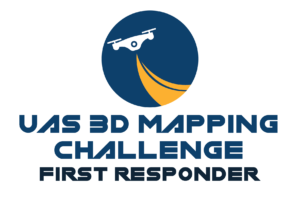Implemented by
| Supported by
Implemented by Capital Consulting Corporation & Kansas State University – Salina, Supported by NIST & PSCR
UAS Design Specification
UAS prototypes entered in this challenge will be subject to the requirements, capabilities, and limitations defined in the UAS Design Specification. The UAS must not be a completely unaltered commercial off-the-shelf UAS as the intent of the challenge is to design a UAS that is purpose-built to the objectives and requirements of the challenge. The “Minimum Capability” represents mandatory capabilities of the UAS and minimum acceptable values for the specific requirement. The “Preferred Capability” provides guidance where higher standards are sought and expected. Each Minimum or Preferred Capability applies to all stages of the challenge unless a deviation is noted.
| Requirement Title | Requirement Details |
|---|---|
Uncrewed Vehicle (UV) |
Requirement DefinitionUncrewed vehicle must include the wireless communication link, all sensors used for detection, mapping, and communication with the ground control station. Minimum CapabilityOne aerial UV. Preferred CapabilityOne primary aerial UV plus additional aerial or ground vehicles in any combination; additional UVs are not required to provide all the capabilities of the primary UV. |
Autonomy |
Requirement DefinitionThe amount of independent control a system (UAS, rover, etc.) has, defined by how much human interaction is required for operation. Minimum CapabilityNo more than two UAS operators and support personnel. Preferred CapabilityAutomated route planning and navigation. |
Bill of Material (BOM) Total Cost |
Requirement DefinitionThe total build price of the complete, ready-to-operate system, including all components (vehicles, control stations, computers, software, etc.), and any fees (e.g., subscription, license) necessary for operation. If applicable, all fees must include at least six months of access to the subscribed or licensed services in the total cost. Minimum Capability≤ $20,000 Preferred Capability≤ $10,000 |
Indoor 3D Map Deliverable |
Requirement DefinitionResolve a complete 3D map of the indoor search area, including obstacles in a challenging and dynamic indoor environment; this must be delivered to the Incident Commander in a digital file format. Minimum Capability3D Map in an open or common industry format delivered on portable media storage (e.g., USB drive, SD card):
Preferred Capability3D Map in an open or common industry format delivered on portable media storage (e.g., USB drive, SD card):
|
3D Map Progress Display |
Requirement DefinitionTeams must show the Incident Commander a visual display of the progress of the 3D scan during the mission. This must include information from the beginning of the scan to the present. Minimum CapabilityNear real-time 3D environment rendering with no more than ten seconds of latency between a scan of an area and the rendering. Preferred CapabilityReal-time 3D environment rendering during mission |
Map Data Acquisition Speed |
Requirement DefinitionAverage forward scanning progress through the environment across all vehicles. While there are no scanning distance requirements, this average value assumes a six-foot scan distance (including lateral and vertical). Minimum CapabilityAverage ≥ 2 ft/s. Preferred CapabilityAverage ≥ 4 ft/s |
Human Detection |
Requirement DefinitionIdentify and communicate the relative location of people within the search environment to the Incident Commander. Minimum CapabilityManual detection via real-time video feed / verbal location description Preferred CapabilityAutonomous detection/location tagging of humans within real-time environment rendering or real-time video feed |
Real-Time Video |
Requirement DefinitionCameras that provide the UAS operator(s) at the Ground Control Station (GCS) with a video stream as it occurs or within milliseconds of viewing the surroundings. Minimum CapabilityAt least 640×480 pixels at 10 frames per second imagery Preferred CapabilityMaximize resolution; 2-3 Axis Gimbal; Onboard recording; RGB (color) video; Thermal (Infrared); Night Vision (low lux); encrypted link |
Additional Preferred Capabilities (No minimum) |
|
Real-Time Audio |
Requirement DefinitionCapability for remote vehicle operators to receive or transmit audio for communication. Minimum CapabilityNone Preferred CapabilityDemonstrated capability |
Auto-Flip (Turtle) |
Requirement DefinitionThe capability of the remote vehicle to right itself after landing in an abnormal orientation Minimum CapabilityNone Preferred CapabilityDemonstrated capability |
Blue or Green UAS Capable |
Requirement DefinitionDemonstrate secure UAS components that are capable of achieving 2020 National Defense Authorization Act (NDAA) Section 848 compliance (Blue) or the AUVSI adaptation of NDAA Section 848 compliance (Green). More Info: https://www.diu.mil/blue-uas-policy Minimum CapabilityNone Preferred CapabilityDemonstration of Flight Controller, Operating Software, and Ground Control Station capable of achieving Blue or Green UAS compliance per the policy. Maximize the remaining six critical components outlined in the NDAA Section 848 or the AUVSI adaptation of NDAA Section 848. |
Safety Specific Requirements
- All flights shall comply with local, state, and Federal laws and regulations.
- All flights shall occur at authorized uncrewed aerial vehicle flying areas.
- All UAS competing in the challenge must follow Federal Aviation Administration (FAA) rules and regulations if flight operations occur in the FAA’s jurisdiction.
- All UAS competing in the challenge must follow Federal Communications Commission (FCC) rules and regulations. Unlicensed and licensed frequencies are authorized. For every RF transmission device used (e.g., telemetry, video, controller), contestants must present FCC ID, FCC license for the frequency, or FCC letter of authorization. If using a licensed frequency, challenge participants must present an FCC license for the frequency.
- Any design that is deemed to pose a significant risk may be disqualified or not selected to advance.
- All UAS components’ primary power source shall be batteries.
- For each vehicle, one or both UAS operators must have direct control or the ability to intervene at any time.
- All UAS shall be equipped with a flight termination system or “kill switch.”
- The command and control (C2) datalinks for all vehicles must maintain connectivity at all times.
- Frequency Hopping Spread Spectrum (FHSS) and encrypted links are preferred.
- Should a vehicle lose C2 connection, it must land in place and stop all motion within a predefined time limit.
Implemented by
| Supported by
Implemented by Capital Consulting Corporation & Kansas State University – Salina, Supported by NIST & PSCR

